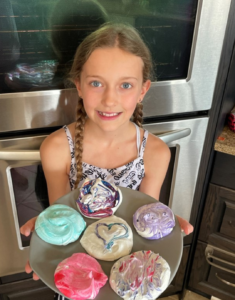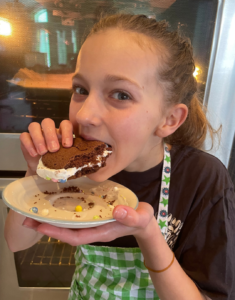Celiac Kids
Helping Your Celiac Child Cope with the Gluten Free Diet
As a parent, having a child with celiac disease means you’re going to have to pay a bit more attention to what’s in your child’s food. Your child must eat gluten free, all the time, to stay healthy. Your job is to teach your child how to eat gluten free while providing strength and support as your child adjusts to a gluten free diet. Luckily there are so many great gluten free products available in Edmonton today, adjusting to a gluten free diet isn’t that hard.

When your child is first diagnosed:
Realize it’s not that bad. It is natural for your child’s diagnosis to cause you to feel dismay. It is also normal that you, as a parent, might have concerns about your ability to keep your child’s diet gluten free. While it’s important to acknowledge these feelings, your views and reactions to celiac disease and the gluten free diet become your child’s views. Focus on what you and your child can do with the diet, not on the diet’s limitations. And remember that there are fewer limitations today than ever before, as well as many resources you can draw on.
Educate yourself. Your child looks exclusively to you, trusts your choices unquestioningly, and believes what you believe—that life with celiac disease is hard and unfair or that it is just a matter of choosing different foods. Educate yourself so you and your child feel more comfortable with celiac disease. Celiac Canada and Celiac Edmonton are ready to help you with a support network and information. Your doctor can also help.
Involve your child. Ultimately, your child will have to become responsible for his or her diet. Teach your child how to read labels—every time—and how to select gluten free food as soon as he or she is old enough. Early training in the gluten free lifestyle results in acceptance and empowers your child to make safe food choices by recognizing potential danger.
Be sensitive. Your child’s gluten free diet might mean additional work for you as you learn where to find products and adjust to your child’s diet. But don’t make your child feel guilty about this by making the diet seem like a burden. It will soon get easier.
Helping your child live gluten free at home:
Diligently train your child to adhere to the gluten free diet.
Make sure everyone who may offer your child food knows that your child has celiac disease. Post a comprehensive list of foods/ingredients that your child must avoid for caregivers to refer to. Distribute this list to friends and relatives.
Remember that people who do not live with celiac disease on a day-to-day basis have a hard time remembering where hidden gluten is lurking and need to be reminded often.
Reinforce the importance of following the gluten free diet with your child. Your child may be tempted to slack off unless you are firm and unbending on this issue.
Allocate a special section of your kitchen and fridge as a gluten free zone, off limits to others in the family. This zone should include:
- A special cupboard, with your child’s own toaster or toaster bags, cutting board, and gluten free foods
- A crisper and/or section in the fridge, with the celiac’s butter, peanut butter, snacks, etc.
- Counter space and a place at the table
Put coloured stickers on food items so your child can easily tell what to eat.
Check what will be served when your child is invited out, and send along substitutions when necessary.
Be patient, understanding, and extra creative when your child feels anxious about being left out of the advertised food fads.



The gluten free diet at school:
Talk to the teacher before school starts. Provide literature about celiac disease— Celiac Canada offers a brochure for teachers—and a comprehensive list of foods/ingredients that your child must avoid. Ask the teacher to have every adult who will be serving as an instructor or an aide read this information before school starts. A notice about your child’s food intolerances should be posted for substitute teachers.
Discuss the need for bathroom privileges with the teacher, if necessary.
Talk to your child and your child’s teacher about what snacks are okay, and offer to supply gluten free snacks on occasion.
Be prepared for birthday and holiday treats. Bake chocolate and vanilla cupcakes at the beginning of the year and freeze them in individual bags. These can be quickly defrosted and decorated with frosting for special occasions.
Supply the teacher with letters to the other parents in your child’s class. The notes should briefly explain your child’s dietary concerns and include your name and contact information.
Get a schedule of which parents are supplying snacks. Then call the snack parent a few days in advance to see what they are bringing so you have time to prepare something similar but gluten free.
Give the teacher a box of “just in case” cookies at the beginning of the year. This way, your child will have a special treat if a special occasion arises that you were not aware of.
Visit the cafeteria at the beginning of the school year and read the labels of items that you feel may be gluten free. Call the companies to check if you have any questions, then tell your child which items are safe choices. Although main dinner items will likely be too risky, the opportunity to go to the cafeteria with friends may be important, and this will ensure your child has an option or two.
Respect your child’s wishes about disclosure. Some kids feel comfort in having others know that they have celiac disease. Other children prefer to handle situations more quietly and confidentially to avoid being singled out.
Focus on the positive aspects. You may have an opportunity to show other parents that it is possible to choose healthier snacks rather than always supplying cupcakes.
If the teacher is receptive (and you have time), do some research and create a small cookbook of unique snack ideas for the teacher to circulate. Options don’t always have to be gluten free, but the cookbook is an opportunity to introduce more gluten free choices, like raw fruits and vegetables.
Gluten Free Snack Ideas:
- Fresh fruit slices
- Most canned fruit
- Cheddar cheese cubes
- Raisins
- Pumpkin or sunflower seeds
- Nuts (but other children might have allergies)
- Popcorn
- Corn chips and corn nuts (for children three yeas and over)
- Carrot and/or celery sticks with peanut butter (make sure it is a gluten free brand) as a dip
- Gluten free yogurt
- Fruit popsicles (always check to see if gluten free)
- Rice crackers with gluten free peanut butter
- Mini muffins from any gluten free mix
- Gluten free fruit juices
- Gluten free granola bars
- Dried fruit (make your own)